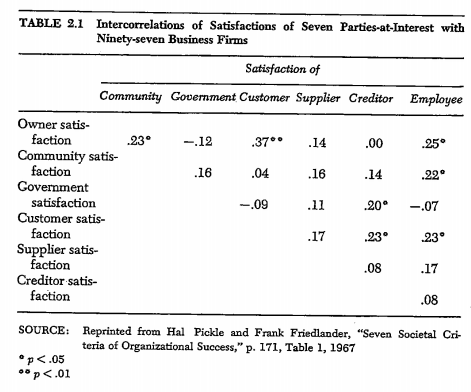That different people, groups, or organizations may have different criteria for evaluating an organization creates problems for the organization. The problems derive from the fact that the criteria may be incompatible. Faced with conflicting demands, the organization must decide which groups to attend to and which to ignore. When the criteria are compatible, the organization would find that satisfying one group would also increase the satisfaction of others. The existence of incompatible demands raises the possibility that the organization may not be able to maintain the necessary coalition of support. Favoring one group offends another.
There is some empirical evidence consistent with the position that organizations confront incompatible demands. Friedlander and Pickle (1968) studied 97 small businesses in Texas. They identified several internal and external interest groups relevant to the Texas businesses, including the owners, the employees, the customers, the suppliers, the creditors, the local community, and the federal government. For each group, the authors developed a measure of the organization’s effectiveness on the group’s criteria. For example, the owners were postulated to be interested in profits, while employees were thought to be concerned with their satisfaction with work. Through a combination of direct questioning and the use of records, measures were developed for how effectively the organization was meeting the demands of the various constituent groups. While there are difficulties with some of the measures, the approach employed demonstrated a realization of the interest-group characteristic of organizational effectiveness seldom seen.
Pickle and Friedlander (1967:171) correlated the indices of group satisfaction with each other across the organizations to examine how the satisfaction of one group’s demands was related to the satisfaction of others. These correlations are presented in Table 2.1. Three points can be made about the data: (1) the correlations are fairly low, (2) the correlations are generally positive, and (3) the correlations between the satisfactions of some groups are greater than between others. These data suggest that one group’s satisfaction implies very little about another group’s satisfaction, and their interests, on occasion, will conflict.
While the analysis discussed was made only for the prominent interests of a few Texas small businesses, there is some generality to the idea that the demands of coalition participants will not always be consistent. It is plausible that with increasing size an organization is likely to be confronted with increasingly inconsistent interests. As an organization becomes large, it generally attracts more attention and establishes coalitions with a more heterogeneous set of organizations.

Because an organization survives only to the extent it creates and maintains the coalition of support necessary for operation, the existence of competing demands can be a problem. Each time the organization satisfies the demands of one participant or interest group it simultaneously constrains its own behavior in meeting other or sub- sequent demands. To the extent that future demands from other participants will conflict with the first, the constraints on behavior may lessen the ability of the organization to establish the necessary coalitions. The consequences may not appear immediately, and the organization may not be aware of them. In general, however, the constraints imposed by satisfying one set of demands affect the organization’s ability to satisfy-others.
Many of New York City’s troubles in 1975 resulted from the accumulation of concessions made to one part of their constituent environment, placing constraints on the city such that future administrators could not satisfy the demands of other interests. Earlier concessions to city workers and various income groups made it subsequently more difficult to satisfy the demands of creditors. Similar situations exist in home building and railroading, where concessions on work rules, made over the years to various unions, have severely restricted management’s ability to adapt to changing competitive and economic conditions.
Source: Pfeffer Jeffrey, Salancik Gerald (2003), The External Control of Organizations: A Resource Dependence Perspective, Stanford Business Books; 1st edition
